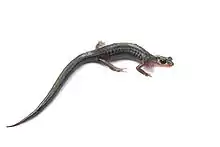Northern gray-cheeked salamander
The northern gray-cheeked salamander (Plethodon montanus) is a species of salamander in the family Plethodontidae and endemic to the Blue Ridge Mountains and Appalachian Mountains in the eastern United States. It is closely related to the Red-cheeked salamander and the Red-legged salamander. Its natural habitat is temperate forests. It is found under moss, rocks, logs, and bark in cool, moist forests above 2500 feet. Especially found in spruce-fir forests. The Gray-cheeked Salamander commonly eats millipedes, earthworms, crane flies, spiders, and centipedes and less commonly eats ants, mites, and springtails.[2] They eat spiders, moths, flies, beetles, bees, and snails.[3] The male and female perform a courtship, where the male nudges the female with his snout, does a foot dance, then circles under the female and the two then walk together.[4] Like other salamanders, they do not migrate or aggregate during breeding season. [5] It is threatened by habitat loss.[1]
| Northern gray-cheeked salamander | |
|---|---|
 | |
| Scientific classification | |
| Domain: | Eukaryota |
| Kingdom: | Animalia |
| Phylum: | Chordata |
| Class: | Amphibia |
| Order: | Urodela |
| Family: | Plethodontidae |
| Subfamily: | Plethodontinae |
| Genus: | Plethodon |
| Species: | P. montanus |
| Binomial name | |
| Plethodon montanus Highton & Peabody, 2000 | |
References
- IUCN SSC Amphibian Specialist Group (2014). "Plethodon montanus". IUCN Red List of Threatened Species. 2014: e.T59349A56341130. doi:10.2305/IUCN.UK.2014-1.RLTS.T59349A56341130.en. Retrieved 16 November 2021.
- Beamer, David; Lannoo, Michael. "Plethodon montanus". Amphibia Web. University of California. Retrieved February 9, 2021.
- "Northern Gray-cheeked Salamander, Plethodon montanus, Plethodon jordani". Tennessee Wildlife Resources Agency. Retrieved January 30, 2021.
- "Northern Gray-cheeked Salamander Plethodon montanus". Virginia Herpetological Society. Virginia Herpetological Society. Retrieved January 30, 2021.
- "Museum Specimens Reveal Life History Characteristics in Plethodon Montanus". Copeia., vol. 107, no. 4, 2019, pp. 622–31. Retrieved March 16, 2023
